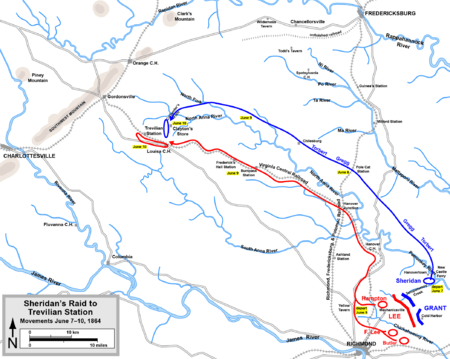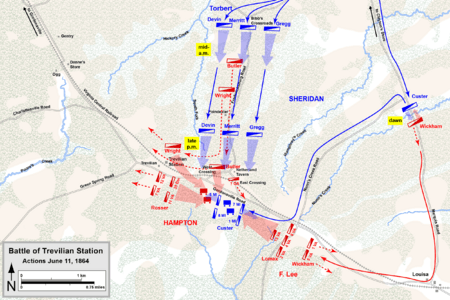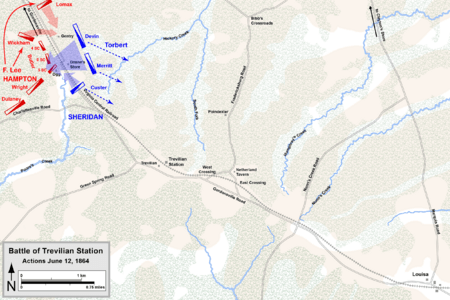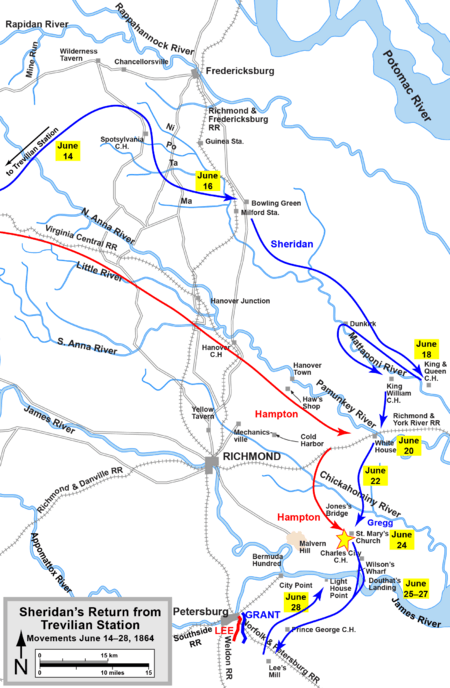Battle of Trevilian Station facts for kids
Quick facts for kids Battle of Trevilian Station |
|||||||
|---|---|---|---|---|---|---|---|
| Part of the American Civil War | |||||||
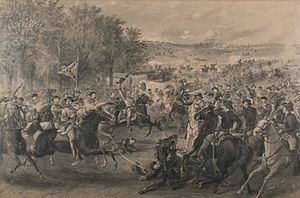 |
|||||||
|
|||||||
| Belligerents | |||||||
| Commanders and leaders | |||||||
| Philip Sheridan | Wade Hampton Fitzhugh Lee |
||||||
| Strength | |||||||
| 9,286 | 6,762 | ||||||
| Casualties and losses | |||||||
| 1,512 total (150 killed; 738 wounded; 624 captured/missing) |
803 total | ||||||
The Battle of Trevilian Station (also called Trevilians) was a major fight between cavalry (soldiers on horseback) during the American Civil War. It happened on June 11-12, 1864, in Louisa County, Virginia. Union General Philip Sheridan led his cavalry against Confederate Generals Wade Hampton and Fitzhugh Lee. This battle was the largest and bloodiest cavalry fight of the entire war.
General Sheridan's main goals were to destroy parts of the Virginia Central Railroad. This railroad was very important for supplying the Confederate army. He also wanted to keep Confederate cavalry busy so they wouldn't notice Union General Ulysses S. Grant's army crossing the James River. Sheridan also hoped to meet up with another Union army led by General David Hunter near Charlottesville.
However, General Hampton's Confederate cavalry reached the railroad at Trevilian Station first. On June 11, the two sides fought hard, and neither gained a clear win. During the battle, Union General George A. Custer managed to get behind the Confederate lines. He captured Hampton's supply wagons but soon found himself surrounded. He had to fight very hard to avoid being captured or destroyed.
On June 12, the cavalry forces fought again, northwest of Trevilian Station. Union attacks were pushed back many times, and the Union side lost many soldiers. General Sheridan then decided to pull his forces back to rejoin Grant's main army. The Confederates won this battle in terms of tactics. Sheridan did not fully destroy the railroad or meet up with General Hunter. But his raid might have helped Grant successfully cross the James River without being noticed.
Contents
Why the Battle of Trevilian Station Happened
After a very tough battle at Cold Harbor on June 3, 1864, General Grant decided to try a new plan. For weeks, his army had been fighting General Robert E. Lee's Confederate army. Each big battle was followed by a pause, then Grant would try to move around Lee's army. These moves brought the armies closer to Richmond, the Confederate capital. But Grant's main goal was to defeat Lee's army, not just capture Richmond.
Grant's new idea was to move his large army of 100,000 men south. He planned to cross the James River and capture Petersburg. Petersburg was a key railroad center. Taking it would cut off supplies to both Richmond and Lee's army. This would force Lee to leave Richmond and fight Grant on ground that favored the Union's larger army.
Grant needed to keep his plan a secret. His army would be vulnerable while crossing the river. He wanted to reach Petersburg before the Confederates could send more soldiers to defend it. So, on June 5, Grant ordered General Sheridan to lead a cavalry raid. Sheridan's mission was to ride northwest toward Charlottesville.
This raid had two main purposes. First, it would draw the Confederate cavalry away from Grant's main army. This would allow Grant's infantry to secretly move away from Lee's army at Cold Harbor. Second, Sheridan's cavalry would destroy the Virginia Central Railroad. This railroad brought much-needed food and supplies from the Shenandoah Valley to Lee's army. Sheridan was told to destroy a bridge and tracks near Charlottesville and Gordonsville. Then, he would destroy tracks all the way back toward Richmond.
Grant later changed his orders slightly. He learned that General Hunter had won a battle in the Shenandoah Valley. Grant thought Hunter could march east to meet Sheridan at Charlottesville. Together, they could pose a big threat to Lee's army from the west.
Who Fought at Trevilian Station
Union Forces
| Key Union commanders |
|---|
|
The Union cavalry force was called the Cavalry Corps of the Army of the Potomac. It was led by Major General Philip Sheridan. He started his raid with two of his three divisions, totaling 9,286 soldiers.
- The First Cavalry Division was led by Brigadier General Alfred T. A. Torbert.
- The Second Cavalry Division was led by Brigadier General David McM. Gregg.
- There was also a Horse Artillery Brigade with 20 cannons.
Sheridan's third cavalry division stayed with the main Union army.
Confederate Forces
| Key Confederate commanders |
|---|
|
The Confederate Cavalry Corps of the Army of Northern Virginia did not have a permanent leader at this time. Their previous commander, General J.E.B. Stuart, had died in May. The highest-ranking cavalry leader fighting Sheridan was Major General Wade Hampton. (He officially became the cavalry commander later in August 1864.) Hampton's force had 6,762 soldiers.
- Hampton's Division was led by Wade Hampton himself.
- Fitzhugh Lee's Division was led by Major General Fitzhugh Lee (who was General Robert E. Lee's nephew).
- They also had a Horse Artillery Battalion with 14 cannons.
Other parts of the Confederate cavalry stayed with the main army.
Sheridan's Raid Begins
Sheridan and his two cavalry divisions left their camps near Cold Harbor early on June 7. They crossed the Pamunkey River and headed northwest. The weather was very hot, and huge clouds of dust rose from their march. On the first day, they only traveled about 15 miles. Many horses collapsed from the heat and had to be shot. The soldiers carried only three days' worth of food. They were expected to find more food and supplies along the way.
Confederate scouts quickly told General Hampton about Sheridan's movements on June 8. Hampton correctly guessed that the Union cavalry was heading for the important railroad junctions at Gordonsville and Charlottesville. He knew he had to move fast to stop them. He ordered his own division to get ready by 2 a.m. on June 9, and told Fitzhugh Lee to follow as quickly as possible.
Even though the Union forces had a two-day head start, the Confederates had a shorter route. Their path was about 45 miles, while the Union's was about 65 miles. The Confederates also knew the land better. By the evening of June 10, both armies were close to Trevilian Station. This station was named after Charles Goodall Trevilian, who owned a nearby plantation.
The Battle of Trevilian Station
Fighting on June 11, 1864
At dawn on June 11, General Hampton was woken by the sound of Union bugles. His brigade commanders had already woken their men. Hampton told them, "I propose to fight!"
Hampton learned that Sheridan's forces would approach the railroad from Clayton's Store. He knew there were two roads from that crossroads, both going through thick woods. One road led to Trevilian Station, and the other to Louisa Court House. Hampton planned to split his divisions. They would attack the Union forces at the crossroads, pushing them back to the North Anna River. Hampton took two of his brigades with him toward Trevilian. His third brigade stayed on his left to protect his flank. Fitzhugh Lee's division was ordered to advance from Louisa Court House, forming the right side of the Confederate attack.
As the Confederates began to move, Sheridan's forces also started their advance. Union brigades moved down the road to Trevilian Station. Another brigade, led by General Custer, advanced toward Louisa Court House. The first fighting happened on the Trevilian Road. Hampton's men got off their horses and pushed the Union skirmishers back into the woods. Hampton was waiting for Fitzhugh Lee to arrive on his right. However, Hampton was greatly outnumbered and soon had to fall back. After several hours of close fighting, his men were pushed back close to Trevilian Station.
On the right side, Fitzhugh Lee's men met Custer's advancing brigade. Lee's men fought briefly and then pulled back. Custer, meanwhile, took a more direct road southwest to Trevilian Station. He found the station completely unguarded. It was only occupied by Hampton's supply trains. These included wagons, ammunition carts, and hundreds of horses. Custer ordered his men to charge and capture everything.
Custer's men captured 800 prisoners, 90 wagons, six ammunition carts, and 1,500 horses. But this left Custer cut off from the rest of Sheridan's army. As they chased the fleeing wagons, they lost some of their own men and much of their captured goods. A Confederate regiment got between Custer's force and Trevilian Station. Custer ordered a charge, driving them back.
Hampton soon learned about the threat behind his lines. He pulled one of his brigades from his left flank and sent them to the station. Lee's forces also approached from Louisa Court House, and other Confederate brigades joined in. Suddenly, Custer found himself surrounded on three sides at the station. He pulled out and headed along the Gordonsville Road, taking his captured supplies with him. However, he didn't notice a Confederate artillery battery on a hill. The cannons opened fire as soon as his men were in range. At this point, Hampton's charging brigades overwhelmed Custer's right side.
Custer was now almost completely surrounded. His soldiers were in a shrinking circle, being attacked from all sides. Custer feared his flag would be captured. He tore it from its staff when the flag-bearer was hit and hid it inside his coat. Sheridan heard the heavy firing from Custer's direction and realized he needed help. He charged with his brigades, pushing Hampton's men back to the station. Another Union brigade attacked Fitzhugh Lee's exposed right side, pushing him back. Hampton fell back to the west, and Lee to the east. The day's battle ended with the Union forces holding Trevilian Station. Custer's brigade had suffered many losses. When Sheridan asked Custer if he had lost his flag, Custer pulled it from his coat and said, "Not by a damned sight!"
That night, Fitzhugh Lee moved south to meet up with Hampton west of Trevilian Station. Sheridan learned that General Hunter was not coming to Charlottesville. Instead, Hunter was heading to Lynchburg. Sheridan also heard that Confederate infantry were nearby, blocking his way. So, he decided to end his raid and return to the main Union army.
Fighting on June 12, 1864
On June 12, the Union cavalry prepared to leave. Gregg's division destroyed Trevilian Station, some railcars, and about a mile of track east of the station. Torbert's division tore up track to the west. Around 3 p.m., Sheridan sent Torbert's brigades to scout west on the Gordonsville and Charlottesville roads. They found Hampton's entire force dug in behind log defenses. These defenses were shaped like an "L" at the Ogg and Gentry farms, two miles northwest of Trevilian.
Torbert launched seven attacks against the Confederate lines. But his brigades were pushed back each time, with heavy losses. Fitzhugh Lee then moved his division to attack the Union's right side. The battle ended around 10 p.m., with both sides still in their positions. However, late that night, Torbert pulled back. Sheridan decided to withdraw because he had many wounded men, about 500 prisoners, and was running low on ammunition. He planned a slow march back to Cold Harbor. He knew Hampton would have to follow him, keeping the Confederate cavalry busy for days and away from Robert E. Lee's main army.
What Happened After the Battle
The Battle of Trevilian Station had mixed results. The Union army lost 1,007 soldiers (102 killed, 470 wounded, and 435 missing or captured). Confederate losses were reported as 612, but a better estimate is 831. It was the bloodiest and largest all-cavalry battle of the entire war.
Sheridan claimed the battle was a Union victory. He wrote in 1866 that his cavalry was always successful and almost completely destroyed the Confederate cavalry. General Grant's own writings agreed with this idea. Many of Sheridan's biographers also support his claim.
As a way to distract the Confederates, the battle was partly successful for the Union. General Lee did not realize that Grant's army had moved and crossed the James River until Grant started attacking Petersburg. However, Sheridan failed in two important goals. He could not permanently destroy the Virginia Central Railroad. The tracks were repaired within two weeks, and supplies continued to reach Lee's army. Also, Sheridan and Hunter never met up. Hunter was later defeated in another battle and pushed back into Maryland. Some historians argue that if Sheridan had destroyed the railroad, Hunter might have captured Lynchburg. They say the battle was a "complete disaster" for the Union cavalry.
An architect named Frank Furness received the Medal of Honor for his brave actions at the Battle of Trevilian Station.
Preserving the Battlefield
The American Battlefield Trust and its partners have worked to save parts of the battlefield. They have bought and protected over 2,243 acres of land since 2001. Much of this land is now owned by the Trevilian Station Battlefield Foundation. This foundation has created an online tour that starts at the Louisa County Courthouse.
See also
 In Spanish: Batalla de Trevilian Station para niños
In Spanish: Batalla de Trevilian Station para niños







